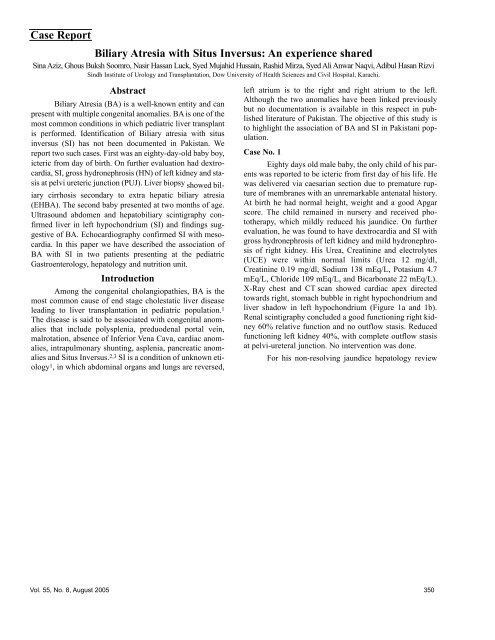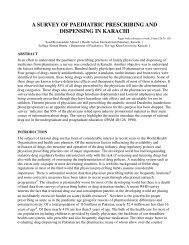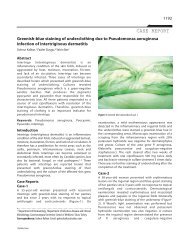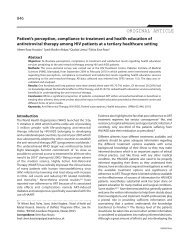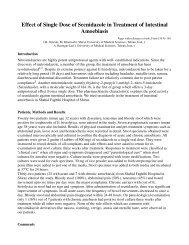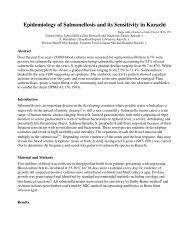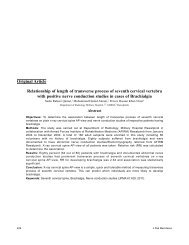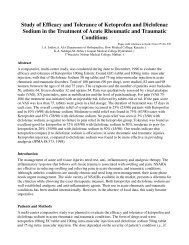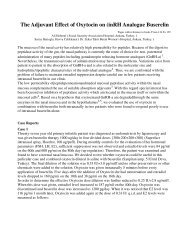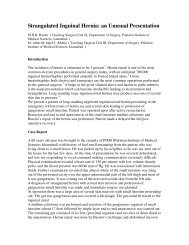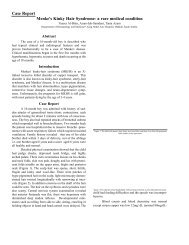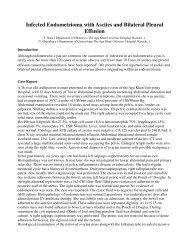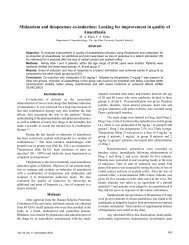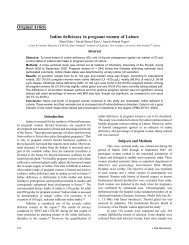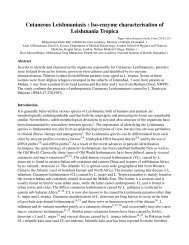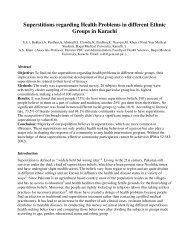Case Report Biliary Atresia with Situs Inversus: An experience shared
Case Report Biliary Atresia with Situs Inversus: An experience shared
Case Report Biliary Atresia with Situs Inversus: An experience shared
Create successful ePaper yourself
Turn your PDF publications into a flip-book with our unique Google optimized e-Paper software.
<strong>Case</strong> <strong>Report</strong><br />
<strong>Biliary</strong> <strong>Atresia</strong> <strong>with</strong> <strong>Situs</strong> <strong>Inversus</strong>: <strong>An</strong> <strong>experience</strong> <strong>shared</strong><br />
Sina Aziz, Ghous Buksh Soomro, Nasir Hassan Luck, Syed Mujahid Hussain, Rashid Mirza, Syed Ali <strong>An</strong>war Naqvi, Adibul Hasan Rizvi<br />
Sindh Institute of Urology and Transplantation, Dow University of Health Sciences and Civil Hospital, Karachi.<br />
Abstract<br />
<strong>Biliary</strong> <strong>Atresia</strong> (BA) is a well-known entity and can<br />
present <strong>with</strong> multiple congenital anomalies. BA is one of the<br />
most common conditions in which pediatric liver transplant<br />
is performed. Identification of <strong>Biliary</strong> atresia <strong>with</strong> situs<br />
inversus (SI) has not been documented in Pakistan. We<br />
report two such cases. First was an eighty-day-old baby boy,<br />
icteric from day of birth. On further evaluation had dextrocardia,<br />
SI, gross hydronephrosis (HN) of left kidney and stasis<br />
at pelvi ureteric junction (PUJ). Liver biopsy showed biliary<br />
cirrhosis secondary to extra hepatic biliary atresia<br />
(EHBA). The second baby presented at two months of age.<br />
Ultrasound abdomen and hepatobiliary scintigraphy confirmed<br />
liver in left hypochondrium (SI) and findings suggestive<br />
of BA. Echocardiography confirmed SI <strong>with</strong> mesocardia.<br />
In this paper we have described the association of<br />
BA <strong>with</strong> SI in two patients presenting at the pediatric<br />
Gastroenterology, hepatology and nutrition unit.<br />
Introduction<br />
Among the congenital cholangiopathies, BA is the<br />
most common cause of end stage cholestatic liver disease<br />
leading to liver transplantation in pediatric population. 1<br />
The disease is said to be associated <strong>with</strong> congenital anomalies<br />
that include polysplenia, preduodenal portal vein,<br />
malrotation, absence of Inferior Vena Cava, cardiac anomalies,<br />
intrapulmonary shunting, asplenia, pancreatic anomalies<br />
and <strong>Situs</strong> <strong>Inversus</strong>. 2,3 SI is a condition of unknown etiology1,<br />
in which abdominal organs and lungs are reversed,<br />
left atrium is to the right and right atrium to the left.<br />
Although the two anomalies have been linked previously<br />
but no documentation is available in this respect in published<br />
literature of Pakistan. The objective of this study is<br />
to highlight the association of BA and SI in Pakistani population.<br />
<strong>Case</strong> No. 1<br />
Eighty days old male baby, the only child of his parents<br />
was reported to be icteric from first day of his life. He<br />
was delivered via caesarian section due to premature rupture<br />
of membranes <strong>with</strong> an unremarkable antenatal history.<br />
At birth he had normal height, weight and a good Apgar<br />
score. The child remained in nursery and received phototherapy,<br />
which mildly reduced his jaundice. On further<br />
evaluation, he was found to have dextrocardia and SI <strong>with</strong><br />
gross hydronephrosis of left kidney and mild hydronephrosis<br />
of right kidney. His Urea, Creatinine and electrolytes<br />
(UCE) were <strong>with</strong>in normal limits (Urea 12 mg/dl,<br />
Creatinine 0.19 mg/dl, Sodium 138 mEq/L, Potasium 4.7<br />
mEq/L, Chloride 109 mEq/L, and Bicarbonate 22 mEq/L).<br />
X-Ray chest and CT scan showed cardiac apex directed<br />
towards right, stomach bubble in right hypochondrium and<br />
liver shadow in left hypochondrium (Figure 1a and 1b).<br />
Renal scintigraphy concluded a good functioning right kidney<br />
60% relative function and no outflow stasis. Reduced<br />
functioning left kidney 40%, <strong>with</strong> complete outflow stasis<br />
at pelvi-ureteral junction. No intervention was done.<br />
For his non-resolving jaundice hepatology review<br />
Vol. 55, No. 8, August 2005 350
Figure 1a.<br />
was taken. His liver function tests (LFT) were, total<br />
bilirubin 8.8 mg/dl, direct bilirubin 6 mg/dl, Alanine transferase<br />
(ALT) 44 U/L, Aspartate transferase (AST) 106<br />
U/L, Gamma glutamyl transferase (GGT) 1182 U/L,<br />
Alkaline phosphate 943 U/L, Prothrombin time (PT)<br />
14.8/10.7 sec, Activated partial thromboplastin time<br />
(APTT) 35.7/28.7 sec and International normalization ratio<br />
(INR) 1.24. Ultrasound abdomen showed coarse echotexture<br />
of liver. Gall bladder and common bile duct were not<br />
visualized. Other investigations performed included<br />
Hepatitis B surface antigen (HbsAg), Hepatitis C antibody<br />
(<strong>An</strong>ti HCV) and Cytomegalovirus (CMV) PCR were negative.<br />
Toxoplasmosis, rubella, CMV and Herpes (TORCH)<br />
screen was non-conclusive and alpha-1 <strong>An</strong>ti trypsin was<br />
<strong>with</strong>in normal limits.<br />
Figure 1b.<br />
Echocardiography showed dextrocardia <strong>with</strong> SI,<br />
hypertrophied Ventricles <strong>with</strong> ejection fraction (EF) 80%.<br />
Fine ventricular septal defect (VSD), moderate to severe tricuspid<br />
regurgitation (TR) and dilated left atrium (LA).<br />
Hepatic imino di acetic acid (HIDA) scan reported reduced<br />
hepatocyte uptake and impaired clearance, non-visualization<br />
of biliary tree and gut motility, findings suggestive of<br />
BA. Perhepatic cholangiography done, showed failure of<br />
visualization of biliary channels. Liver biopsy revealed<br />
hepatocyte arranged in cords <strong>with</strong> mild degeneration and<br />
cholestasis and sinusoids dilatation. Portal areas showed<br />
marked fibrosis <strong>with</strong> thick periportal band formation, many<br />
normal looking bile ducts seen surrounded by mononuclear<br />
and polymorph infiltrate. Impression was of biliary cirrhosis,<br />
secondary to extra-hepatic biliary atresia or mild form<br />
of intrahepatic biliary atresia.<br />
<strong>Case</strong> No. 2<br />
The patient was the third child of consanguineous<br />
parents <strong>with</strong> two healthy daughters. He was born at term via<br />
normal vaginal delivery following an uneventful pregnancy.<br />
His birth weight and height were less than fifth centile by<br />
National center of health statistics (NCHS) standard4, occipitofrontal circumference (OFC) was normal, <strong>with</strong> no<br />
significant history of birth asphyxia or cyanosis reported.<br />
On third day of life on routine examination, he was suspected<br />
to have congenital heart disease. At 10th day of life due<br />
to umbilical bleeding and low hemoglobin, the child was<br />
transfused. He also received stitches at the site of umbilicus.<br />
This was followed by gradually deepening jaundice and<br />
clay colored stools. When he was two months old he was<br />
admitted in hospital for icterus and low-grade fever. His<br />
liver and spleen were moderately enlarged.<br />
His LFT's at that time were, total bilirubin of 32.8<br />
mg/dl, direct 22.1 mg/dl, Alkaline phosphatase 465 U/L,<br />
ALT 183 U/L, AST 271 U/L, GGT 474 U/L, PT 22.3/11.4<br />
sec and INR 1.33. Microcytic hypochromic, iron deficiency<br />
anaemia was reported on peripheral blood film. HbsAg was<br />
negative and CMV IgM was positive. On echocardiography<br />
the child had situs inversus <strong>with</strong> mesocardia and complete<br />
atrioventricular canal defect committed to right ventricle<br />
(RV). Transposed great arteries <strong>with</strong> valvular and<br />
infundibular pulmonary stenosis were observed. This gave a<br />
conclusive diagnosis of complete cyanotic congenital heart<br />
disease. Ultrasound abdomen showed left sided, normal<br />
sized liver whereas gall bladder and common bile duct were<br />
not visualized. Hepatobiliary scintigraphy showed that the<br />
liver was located in the left hypochondrium (SI), <strong>with</strong> fair<br />
hepatocyte uptake and impaired clearance, non-visualized<br />
gall bladder and common bile duct. Findings were suggestive<br />
of BA.<br />
Discussion<br />
BA, also called progressive obliterative cholangiopathy<br />
in affected infants is present since birth. Genetic<br />
factors are suggested and inference of analysis of segregation<br />
patterns rationalizes the existence of two groups, one<br />
<strong>with</strong> various anomalies <strong>with</strong>in the laterality<br />
351 J Pak Med Assoc
sequence and the other involving the cardiac, gastrointestinal<br />
and urinary systems. 5 These two patients identify<br />
<strong>with</strong> the first group mentioned above.<br />
Also, to ones interest the first child had unilateral<br />
complete outflow stasis at pelviureteral junction leading to<br />
reduced functioning of kidney, which in our knowledge has<br />
not, been documented before <strong>with</strong> biliary atresia. This is an<br />
important finding as we can easily miss the co existence of<br />
BA in a patient suffering from pelviureteric junction<br />
obstruction and vice versa unless one has in mind the coalition<br />
between the two.<br />
BA is said to occur in 28% of infants born <strong>with</strong> SI as<br />
compared to the 0.01% of the general population. 6 These<br />
figures suggest a significant incidence of this entity, yet not<br />
reported in the past in Pakistan. As the presence of two conditions<br />
simultaneously modifies the pre operative evaluation7,<br />
standard operative techniques of liver transplantation7,8<br />
and post operative complications specific for <strong>Situs</strong><br />
<strong>Inversus</strong> 6, we have in particular <strong>shared</strong> this <strong>experience</strong> here.<br />
References<br />
1. Schreiber RA, Kleinman RE, <strong>Biliary</strong> <strong>Atresia</strong>, JPGN 2002;35 S11-S16.<br />
2. Tanano H, Hasegawa T, Kawahara H, Sasaki T, Okada A. <strong>Biliary</strong> atresia associated<br />
<strong>with</strong> congenital structural anamolies. Paed. Surg 1999;34:1687-90.<br />
3. Llorente AM, Espinosa LJA, Lopez J, Sanchez LM, Valdez C, Blanco FC, et<br />
al. First orthoptic liver transplant in-patient <strong>with</strong> biliary atresia ans situs inversus<br />
in Spain. Cir Paed 2003;16:44-7.<br />
4. Hamill PV, Dridz TA, Johnson CL, Reed RB, Roche AF, Moore WN. Physical<br />
growth: National center for health statistics percentiles. AmJ Clin Nutr<br />
1979;32:614.<br />
5. Stoll C, Morali A, Leheup B, Lucron H. Extrahepatic biliary atresia <strong>with</strong> laterality<br />
sequence anomalies. Genet couns 2001;12:157-6.<br />
6. Farmer DG, Shaked A, Olthoff KM, Imagawa DK, Millis JM, Busuttil RW.<br />
Evaluation, operative management, and outcome after liver transplantation in<br />
children <strong>with</strong> biliary atresia and situs inversus <strong>An</strong>n Surg 1995;222:47-50.<br />
7. Colomb K, Mizrahi S, Downes T, Hayes DH, Hussey JL, Boudreaux JP. Liver<br />
transplantation in-patients <strong>with</strong> situs inversus. Transpl Int 1993;6:158-60.<br />
8. Mattei P, Wise B, Schwarz K, Klein A, Colombani PM. Orthotopic liver transplantation<br />
in-patients <strong>with</strong> biliary atresia and situs inversus. Pediatr Surg Int<br />
1998;14:104-10.


